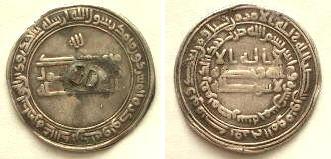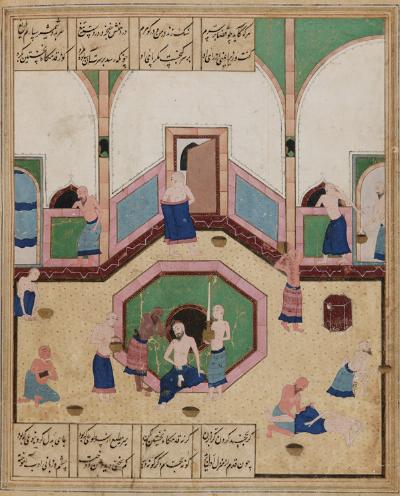seventh caliph of the Abbasid dynasty, b. 786 (Baghdad), d. August 833 (Tarsus, Cilicia).
Al-Ma'mun was the eldest son of Harun ar-Rashid. Because his mother was a Persian concubine, he could not expect to have a right to succeed his father and had to accept the priority of his half-brother al-Amin, who was born six months after al-Ma'mun, the son of a legitimate wife of Arab descent.
As the boys grew up it became evident that al-Ma'mun was by far the more intelligent of the two. Harun could not decide on his accession and in 802 declared that al-Amin should become the caliph of Baghdad and al-Ma'mun the sovereign of the eastern provinces with his capital at Merv in Khorasan (today's Turkmenistan).

coinage minted under Al-Ma'mun
Illustration: public domain
After Harun ar-Rashid's death in 809 civil war broke out and lasted for four years. Supported by the Iranian al-Fadl ibn Sahl (who became al-Ma'mun's vizier) and the Iranian general Tahir, al-Ma'mun eventually took Baghdad in 813. Al-Amin was killed, possibly against the orders of al-Ma'mun.
The underlying cause of the war had been a conflict between the Persian civil servants of the empire, who wanted to foster contact with the outside world and were open to innovation, and the Arabian religious scholars, who were determined to impose Arab culture and traditions on the people of the empire. This conflict found expression in religious controversy between Sunnite (the Arab side) and Shi'ite (Persian) Islam. Al-Ma'mun's aim was to unify his empire and engender consensus between its people, but his methods and the circumstances frustrated his efforts.
As an Abbasid caliph al-Ma'mun was a Sunnite. His first attempt at reconciliation proved disastrous: He married his daughter to Ali ar-Rida, a Shi'ite and direct descendant of the prophet Muhammad's cousin and son-in-law Ali, who the Shi'ites regard as the rightful successor to the prophet, and he declared Ali ar-Rida his successor.
The result was a revolt in Baghdad in 818. Al-Ma'mun decided to move from Merv to Baghdad. While travelling, his vizier al-Fadl, who had supported his policy, died, and within weeks Ali ar-Rida died under suspicious circumstances, possibly by poison.
Disillusioned with court politics, al-Ma'mun did not appoint another vizier and successor but controlled his ministers himself and concentrated on developing his empire through the support of science and medicine. He sent a party to the Byzantine emperor to obtain copies of Greek manuscripts, established the Bayt al-hilkma ("House of Wisdom") in Baghdad and ordered the translation of as many manuscripts as possible. The House of Wisdom was the most ambitious establishment of scholarly learning in the Mediterranean region since the Academy in Athens and the Museum in Alexandria. It included a library and an observatory. Another observatory was built on his orders on the plain of Tadmor in Palmyra.
His rationalistic outlook and scientific inclinations led al-Ma'mun to disassociate himself with both Sunnite and Shi'ite Islam and embrace Mu'tazilism. The Mu'tazilah ("those who withdraw or stand apart") were religious neutralists who used Hellenistic rationalism in their religious arguments, stating for example that since God is one and undivisible, the Qur'an could not technically be God's word (i.e. a part of God) and thus had to be created.
Al-Ma'mun's last years were a particularly clear demonstration of early Muslim tolerance towards Christians and Jews and persecution of other Islamic faiths. While Christian, Persian and Jewish scholars worked in the House of Wisdom and were sponsored by the caliph, in 833 al-Ma'mun declared by edict that all his subjects had to adhere to Mu'tazilah faith and did not refrain from executions where his edict was opposed. His sudden death the same year brought this episode, known in Arab history as mihnah ("the trial"), to an end.

Illustration: Al-Ma'mun and the barber, miniature watercolour by Nizami, mid 16th century; © Smithsonian Freer Gallery of Art and Arthur M. Sackler Gallery, reproduced under fair use permission (http://www.si.edu/copyright/).